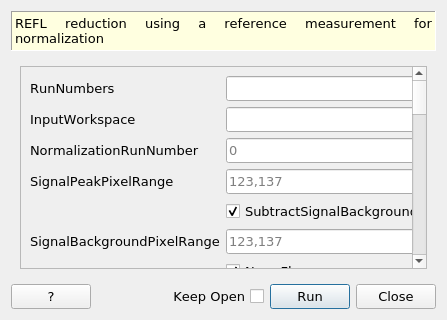\(\renewcommand\AA{\unicode{x212B}}\)
LRReductionWithReference v1¶

LRReductionWithReference dialog.¶
Summary¶
REFL reduction using a reference measurement for normalization
Properties¶
Name |
Direction |
Type |
Default |
Description |
|---|---|---|---|---|
RunNumbers |
Input |
str list |
List of run numbers to process |
|
InputWorkspace |
Input |
Optionally, we can provide a workspace directly |
||
NormalizationRunNumber |
Input |
number |
0 |
Run number of the normalization run to use |
SignalPeakPixelRange |
Input |
long list |
123,137 |
Pixel range defining the data peak |
SubtractSignalBackground |
Input |
boolean |
True |
If true, the background will be subtracted from the data peak |
SignalBackgroundPixelRange |
Input |
long list |
123,137 |
Pixel range defining the background. Default:(123,137) |
NormFlag |
Input |
boolean |
True |
If true, the data will be normalized |
NormPeakPixelRange |
Input |
long list |
127,133 |
Pixel range defining the normalization peak |
SubtractNormBackground |
Input |
boolean |
True |
If true, the background will be subtracted from the normalization peak |
NormBackgroundPixelRange |
Input |
long list |
127,137 |
Pixel range defining the background for the normalization |
LowResDataAxisPixelRangeFlag |
Input |
boolean |
True |
If true, the low resolution direction of the data will be cropped according to the lowResDataAxisPixelRange property |
LowResDataAxisPixelRange |
Input |
long list |
115,210 |
Pixel range to use in the low resolution direction of the data |
LowResNormAxisPixelRangeFlag |
Input |
boolean |
True |
If true, the low resolution direction of the normalization run will be cropped according to the LowResNormAxisPixelRange property |
LowResNormAxisPixelRange |
Input |
long list |
115,210 |
Pixel range to use in the low resolution direction of the normalizaion run |
TOFRange |
Input |
dbl list |
0,340000 |
TOF range to use |
TOFRangeFlag |
Input |
boolean |
True |
If true, the TOF will be cropped according to the TOF range property |
QMin |
Input |
number |
0.05 |
Minimum Q-value |
QStep |
Input |
number |
0.02 |
Step size in Q. Enter a negative value to get a log scale |
AngleOffset |
Input |
number |
0 |
angle offset (degrees) |
AngleOffsetError |
Input |
number |
0 |
Angle offset error (degrees) |
OutputWorkspace |
Output |
Mandatory |
Output workspace |
|
ApplyScalingFactor |
Input |
boolean |
True |
If true, the scaling from Scaling Factor file will be applied |
ScalingFactorFile |
Input |
string |
Scaling factor configuration file |
|
SlitTolerance |
Input |
number |
0.02 |
Tolerance for matching slit positions |
SlitsWidthFlag |
Input |
boolean |
True |
Looking for perfect match of slits width when using Scaling Factor file |
IncidentMediumSelected |
Input |
string |
Incident medium used for those runs |
|
GeometryCorrectionFlag |
Input |
boolean |
False |
Use or not the geometry correction |
FrontSlitName |
Input |
string |
S1 |
Name of the front slit |
BackSlitName |
Input |
string |
Si |
Name of the back slit |
TOFSteps |
Input |
number |
40 |
TOF step size |
CropFirstAndLastPoints |
Input |
boolean |
True |
If true, we crop the first and last points |
ApplyPrimaryFraction |
Input |
boolean |
False |
If true, the primary fraction correction will be applied |
PrimaryFractionRange |
Input |
long list |
117,197 |
Pixel range to use for calculating the primary fraction correction. |
Refl1DModelParameters |
Input |
string |
JSON string for Refl1D theoretical model parameters |
Description¶
The workflow proceeds as follows:
Using the algorithm LiquidsReflectometryReduction, reduce the normalization run for a standard using normalization input parameters: \(I^{standard}(Q)\)
With the input Refl1DModelParameters JSON string, calculate the model reflectivity for the normalization run to produce the theoretical reflectivity of the standard. Uses the refl1d [1] package: \(R_{theory}^{standard}(Q)\)
The reduced normalization run from step (1), \(I^{standard}(Q)\), is then divided by the model reflectivity of the same material from step (2), \(R_{theory}^{standard}(Q)\), to produce the incident flux for normalzing the sample run: \(I_{norm}(Q) = I^{standard}(Q) / R_{theory}^{standard}(Q)\).
Using the algorithm LiquidsReflectometryReduction, reduce the sample run with the normalization turned OFF (i.e. NormFlag set to False): \(I^{sample}(Q)\)
Calculate the sample reflectivity by dividing the sample reduction of step (4), \(I^{sample}(Q)\), by the the normalization in step (3), thus \(R^{sample}(Q) = I^{sample}(Q) / I_{norm}(Q)\).
References¶
Categories: AlgorithmIndex | Reflectometry\SNS
Source¶
Python: LRReductionWithReference.py
